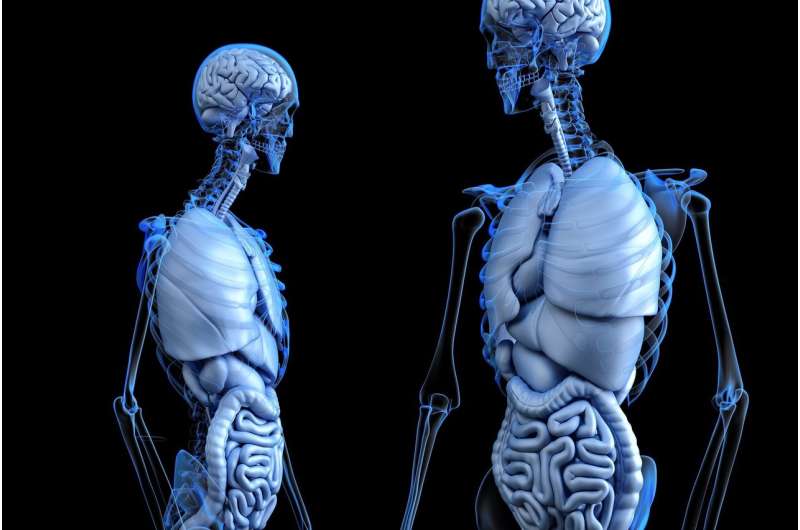Researchers develop technique to replicate bone-remodeling processes

A multidisciplinary team of researchers at the University of Massachusetts Amherst's Institute for Applied Life Sciences (IALS) have developed a technique to replicate bone tissue complexity and bone remodeling processes. This breakthrough could help researchers further their study of bone biology and assist in improving development of drugs for osteoporosis.
Published in Science Advances, the researchers developed a new biomaterial they call demineralized bone paper. The team includes Jungwoo Lee, Yongkuk Park, Ryan Carpenter, chemical engineering; Eugene Cheong, biochemistry and microbiology; Jun-Goo Kwak, molecular and cellular biology graduate program; and Jae-Hyuck Shim of the UMass Medical School in Worcester.
The team developed a trabecular bone organoid model that reproduces essential extracellular complexity and cellular processes of trabecular bone cavities. Trabecular bone, or spongy bone, is a light, porous bone enclosing numerous large spaces that give a honeycombed or spongy appearance. Trabecular bones are the "shock absorbers" of the body, transferring mechanical loads from the articular surface to the cortical bone. These bones have a lower calcium content and more marrow content compared to cortical bone. Trabecular bone density decreases with aging.
"Bone is a multifunctional tissue not only maintaining mechanical stability, but also regulating blood-forming and blood mineral content," Lee says. "However, investigating bone-remodeling biology is challenging because this process occurs inside the bone cavity. Hard and opaque bone tissue is difficult to access, thus creating realistic bone tissue models outside of the body will advance our understanding of fundamental bone biology, as well as provide new opportunities to model disease progression and screening drug responses."
Bone remodeling is a lifelong process during which mature bone tissue is removed from the skeleton and new bone tissue is formed. These processes also control the replacement of bone after an injury and the micro-damage that occurs during normal daily activity. Bone development occurs in a layer-by-layer manner as first bone-forming cells deposit structural collagen that in turn mineralizes to become hard bone. This process is repeated to remodel and model bone tissue throughout life.
The UMass scientists took bovine bones from a local slaughterhouse, then cleaned and cut them into small chunks that they demineralized in a chemical process. To reproduce the bone- remodeling process, the team developed a novel biomaterial, demineralized bone paper, that mimics the dense structural matrix with thin sections of demineralized bovine compact bone. This material has a controlled thickness and surface area. It is mechanically durable and semitransparent, as well.
The demineralized bone paper supports the processes of osteoblasts and osteoclasts, which are cells that exclusively reside and function on the bone surface. Osteoclasts are responsible for aged bone resorption, and osteoblasts are responsible for new bone formation.
The bone paper serves as a functional template on which osteoblasts rapidly deposit structural minerals, guided by lamellar structure of the dense collagen, and form osteoid bone having a depth similar to that seen in a live organism. The material's semitransparency makes it possible to monitor ongoing cellular processes with fluorescent microscopy, and it is thin but durable enough to be handled easily. Bone paper can be produced in large quantities—the team was able to produce more than 5,000 pieces from one bovine femur.
Yongkuk Park, the first author, says the trabecular bone model could be humanized for translational research by replacing bovine bones. Humanized trabecular bone models could improve the predictive power of pre-clinical studies and shorten the screening period for osteoporosis drugs. It could also help researchers facilitate the future study of numerous aspects of bone biology.
More information: Yongkuk Park et al, Trabecular bone organoid model for studying the regulation of localized bone remodeling, Science Advances (2021). DOI: 10.1126/sciadv.abd6495




















